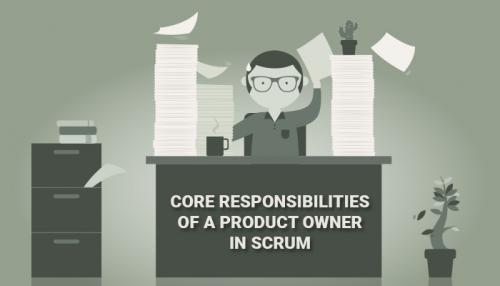CORE RESPONSIBILITIES OF A PRODUCT OWNER IN SCRUM.
 The product owner plays a key role in Scrum. Right from planning the project release and incepting the project, the product owner plans, organizes, estimates, and delivers the project business value to the client. In Scrum, the PO "owns" the product on behalf of the management and stakeholders - individuals who have appointed him or her to develop the project. From Scrum point of view, development is fundamentally carried out to achieve the releases. A product is never considered as "complete" or "fully developed", rather, several versions of the product in the form of releases are delivered to the client. So, in a way, the objective in Scrum is to develop a product release having a certain business value to the client - the client launches the release in the market, earns from it, and subsequently plans how more developed versions of the release can be developed using Scrum so the earning activity does not stop. This is one of the main reasons why a product backlog is always dynamic. When a Scrum team works on a particular release, the same backlog may be used for another release - it is not required to rebuild the product backlog right from scratch for each release. The PO is responsible for delivering all these.
The product owner plays a key role in Scrum. Right from planning the project release and incepting the project, the product owner plans, organizes, estimates, and delivers the project business value to the client. In Scrum, the PO "owns" the product on behalf of the management and stakeholders - individuals who have appointed him or her to develop the project. From Scrum point of view, development is fundamentally carried out to achieve the releases. A product is never considered as "complete" or "fully developed", rather, several versions of the product in the form of releases are delivered to the client. So, in a way, the objective in Scrum is to develop a product release having a certain business value to the client - the client launches the release in the market, earns from it, and subsequently plans how more developed versions of the release can be developed using Scrum so the earning activity does not stop. This is one of the main reasons why a product backlog is always dynamic. When a Scrum team works on a particular release, the same backlog may be used for another release - it is not required to rebuild the product backlog right from scratch for each release. The PO is responsible for delivering all these.In practice, the role of a PO is not an easy one to play. There are many responsibilities of a PO, and they can be briefly categorized as:
- Planning the release as per the client's vision of what the product should be like when launched in the market
- Designing the sprints so that a certain business value is delivered to the client on a consistent basis
- Achieving the product release through daily sprints
- Interacting with the client, stakeholders, end-users, etc.
- Coordinating and dealing with work related issues
Looking at the role played by the PO from a macro level, these are the common core responsibilities that each PO is liable to fulfill. However, at a micro level, the PO also plans out various activities pertaining to the Scrum process.
Product owner - A core determinant of the project
The main tasks of a PO consist of:
- Envisioning the product desired by the client and plan its development
- Design an iterative product increment, or a sprint release strategy that can incorporate changing market conditions as well as quick modifications of product feature requirements
- Distilling high-level product based requirements - Epics - into individually developable and deliverable product backlog items "PBIs" or user stories linked with a certain acceptance criteria (the Definition of Done and the sprint goal)
- Prioritizing the product development by ordering the product backlog
- Communicating and explaining complex system architecture related issues to the client
- Negotiating and resolving all client-sided issues and disputes associated with product design, development, and user story priorities
A common misconception is to think that the PO actually owns the product. In practice, the PO "owns" it with respect to the team, but in reality represents the client's interests. Technically speaking, a product owner can actually own a product, but in that case the client and the PO are the same entities as far as scrum is concerned.
Team responsibilities of the product owner
As far as the team is concerned, the PO is mainly responsible for:
- Represent the interests of, and act as the "voice" of stakeholders, end-users, and customers
- Understand project profitability and deliver high investment returns
- Manage stakeholders
- Maintain communications, and promote collaboration amongst all team members
- Undertake on-the-spot tactical decisions and ensure the product development cycle is not hampered
- Participate in all Scrum events
- Write effective user stories having business values
- Maintain and update the product backlog
- Help the team to estimate the development time
- Accept user stories as "Done" during reviews and provide proper feedback
- Monitor the project progress, and advise constant adjustments in the process flow based upon important strategic objectives
Post Your Ad Here
Comments